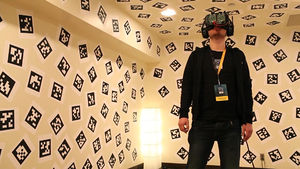Inside-out tracking
- See also: Markerless inside-out tracking and Positional tracking

Inside-out tracking is a method of positional tracking commonly used in virtual reality (VR) technologies, specifically for tracking the position of head-mounted displays (HMDs) and motion controller accessories.
It is egocentric. It usually involves SLAM or VIO for markerless tracking.[1]
It differentiates itself from outside-in tracking by the location of the cameras or other sensors that are used to determine the object’s position in space (Figure 1). In inside-out positional tracking, the camera or sensors are located on the device being tracked (e.g. HMD) while in outside-in the sensors are placed in a stationary location. [2] [3] [4]
A VR device using inside-out tracking looks out to determine how its position changes in relation to the environment. When the headset moves, the sensors readjusts its place in the room and the virtual environment responds accordingly in real time. This type of positional tracking can be achieved with or without markers placed in the environment. The latter is called markerless inside-out tracking. [5]
The cameras (or any other optical sensors) that are placed on the HMD observe features of the surrounding environment. When using markers, these are designed to be easily detected by the tracking system and placed in a specific area. These fiducial markers include primitive shapes like points, squares, and circles (Figure 2). QR codes are an example of positional markers that can be placed in the outside world to serve as reference points for the tracking camera. Inside-out positional tracking can also be achieved using infra-red (IR) markers and a camera that is sensitive to this type of light. In case of using markers, the inside-out system works only as long as it can detect the markers. If these are out of its field of view, positional tracking will be affected. [3] [4] [6]
With markerless inside-out tracking - a method based on natural features - uses distinctive characteristics that originally exist in the environment to determine position and orientation. The system’s algorithms identify specific images or shapes and uses them to calculate the device’s position in space. Data from accelerometers and gyroscopes can also be used to increase the precision of positional tracking. [4] [7]
Devices using Inside-out tracking
HTC Vive (including developer editions)
Nintendo Wii Remote (not officially used for VR)
Inside-out tracking systems
Nintendo Wii Sensor Bar (not officially used for VR)
NMERSO
References
- ↑ "Inside-out tracking". 2024-09-30. https://www.xvrwiki.org/wiki/Inside-out_tracking.
- ↑ Ribo, M., Pinz, A. and Fuhrmann, A.L. (2001). A new optical tracking system for virtual and augmented reality applications. Instrumentation and Measurement Technology Conference Proceedings
- ↑ 3.0 3.1 Boger, Y. (2014). Positional tracking: "Outside-in" vs. "Inside-out.” Retrieved from http://vrguy.blogspot.pt/2014/08/positional-tracking-outside-in-vs.html
- ↑ 4.0 4.1 4.2 Ishii, K. (2010). Augmented Reality: Fundamentals and nuclear related applications. Nuclear Safety and Simulation, 1(1)
- ↑ Langley, H. (2017). Inside-out v Outside-in: How VR tracking works, and how it's going to change. Retrieved from https://www.wareable.com/vr/inside-out-vs-outside-in-vr-tracking-343
- ↑ Mehling, M. (2006). Implementation of a Low Cost Marker Based Infrared Optical Tracking System. PhD thesis, Fachhochschule Stuttgart
- ↑ Boger, Y. (2014). Overview of positional tracking technologies for virtual reality. Retrieved from http://www.roadtovr.com/overview-of-positional-tracking-technologies-virtual-reality/
- ↑ AR/VR Tips (2020). VR Headset Comparison. Retrieved from https://arvrtips.com/vr-headset-comparison-tool/
